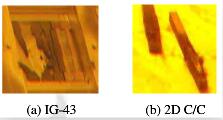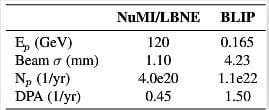Use of graphite and carbon-carbon composite materials as high intensity proton targets for neutrino production is currently thought to be limited by exposure to high energy proton beam. Identification of these limits for various irradiation and thermal environments is critical to high intensity targets for future facilities and experiments. To this end, several types of amorphous graphite and one type of carbon-carbon (3D weave) composite were exposed to 180 MeV proton beam at the BNL BLIP facility. Irradiated samples were then thermally, ultra-sonic, and structurally tested and compared to un-irradiated samples. Results show significant changes in material properties even at very low damage levels (<0.09 DPA) and that significant interstitial annealing of these properties occurs at annealing temperatures only slightly above irradiation temperature to increase target lifetime. A description of the plan to explore radiation damage in target materials through the new Radiate collaboration is also presented.
Multi-MW high performance particle production targets are key toward the next generation of accelerator machines for future neutrino and rare particle beams. One of the future MW accelerators is the LBNE experiment where Fermilab aims to produce a beam of neutrinos with a 2.3 MW proton beam as part of a suite of experiments associated with Project X. These parameters are expected to push many target materials to their limit thus making target design very chanllenging.
Prior radiation damage studies conducted within the last decade at Brookaven National Laboratory using 200 MeV protons at the

fig.1-irradiation-induced-structural-damage-by-200-MeV-protons-at-BLIP
Brookhaven Linac Isotope Producer target station for LHC and Neutrino Factory revealed structural damage of graphite and carbon composites at proton fluence of about 1021 p/cm2 (fig.1). Moreover, recent performance results from the NuMI experiment indicated that target irradiation damage may be responsible for the gradual degradation of neutrino yield.
Prompted by these experimentl and operational observations on targets made of materials desired for the multi-MW LBNE, a comprehensive experimental effort was launched to assess and quantify potential limitaons of LBNE target materials using the BNL proton beam. The main objectives were to evaluate irradiation-induced changes in the thermal and mechanical properties of different low-Z target materials, irradiated at varying DPA levels.
The BNL Linac can deliver protons of energies between 66 and 200 MeV, with a pulse length of 525 μs. The BLIP target station, primarily operated to produce medical isotopes, fully arrests the primary proton beam from the Linac operating at 116 MeV. Therefore, to perform the irradiation experiment in tandem with the isotope production, the Linac energy was increased so that the beam energy was degraded to the desired beam parameters for optimal isotope production after passing through the target array. As a result, significant fine tuning and multiple sensitivity studies were performed to optimize and configure the final target array.
A comprehensive study, using the MARS15 Monte Carlo code, was also launched to confirm whether the irradiation damage

table-1-MARS15-target-damage-comparison-between-165-MeV-BNL-BLIP-and-120-GeV-LBNE-protons
experiment at BLIP would be of value and able to answer important target survivability questions associated with the multi-MW LBNE experiment. Table 1 shows a direct comparison of target damage between BLIP and LBNE, which demonstrates the significant effect of proton energy on damage. It was therefore estimated that for the assumed BLIP beam parameters, one year of accumulated damage of the LBNE target, operating at 120 GeV/700 kW, can be achieved at BLIP in about 9 weeks of irradiation.
The LBNE BLIP irradiation experiment included various graphite grade specimens as well as the 3D C/C composite. The peak DPA damage in the target specimens was estimated by MARS15 simulations to be about 0.095. Following irradiation, the target array was allowed to cool down for several months before being transported to the hot cell facility, where post-irradiation experiments were carried out.